In a recent session with Marko S. Sipilä, the founder of CoatingLaunch, we discussed how you can use the Dollar a Day strategy as a powerful tool for your home service business. You can generate leads, address customer service issues, secure partnerships, or achieve any other goal using the Dollar a Day strategy on any social media platform, including Google.
However, many people don’t realize that the key to successful social media ads isn’t just about creating a clever video, having a well-known personality, or tweaking your ads properly.
Experts in Google and social media advertising believe that 80% of success comes from the initial setup, reflecting the 80/20 rule. It’s crucial to get the setup right, (which we call “Goals, Content, Targeting”), by testing which ads work with your ideal audience.
We do this by measuring the effectiveness of our ads using the Dollar a Day strategy, aiming for a 10 percent click-through rate (CTR). This means that for every ten people who see the ad while scrolling, one person engages with it.
Once we identify the ads that meet this threshold, we scale up the investment in those ads.
Why One Ad Isn’t Enough: The Power of Testing Multiple Variations
The Golden State Warriors is a basketball team. We managed their advertising for five and a half years, typically running twenty to thirty different ads at any given time.
Interestingly, only one in ten ads would stand out as a winner, and none of us, including their CMO could predict which one it would be. Our guesses were always wrong.
The same is going to be true for your ads. So it’s important never to rely on just one ad.
Instead, create ten different versions and use the Dollar a Day approach to identify the most effective one.
For example, play with different variations of the hook, the body and the call to action.
- The Hook: This is the beginning part of your ad, designed to catch the viewer’s attention.
- The Body: Here, you explain what your business does or what you’re offering.
- The Call to Action: This could be anything from “Call us” to “Book an appointment” or “Get a free estimate.”
By experimenting with different versions of these components of a conversion ad, you’ll find which combination works best for your audience.
Reach Your Ideal Customers with Easy Geo Targeting
Years ago, when we first started using Facebook ads, we targeted many specific interests – like moms with station wagons or new homeowners. We tried to match our messages to these specific groups.
Now, the strategy has shifted: instead of many targets, we use lots of content.
You set one broad target, like your local area, and create various pieces of content.
For example, if you’re targeting Maricopa County, Arizona, just set it as your geographic target without adding any specific interests.
Then make sure your content and copy are tailored for your target audience, such as “Arizona homeowners” interested in “painting” services.
And then your content and the campaign objective that you choose, will guide the targeting process.
The algorithm will automatically identify and target the right audience based on this setup. That’s the number one thing people don’t understand.
Detailed targeting is no longer effective on platforms like Facebook because of the various changes and regulations, such as concerns about redlining and discrimination.
Fifteen years ago, your ad could reach 4000 people with a dollar a day. Today, it might only reach about 50 people. But if you reach exactly the right people, then the results are amazing.
When you test several ads at a dollar a day for a week, you can then narrow them down to ten winners that have a 10% or more CTR.
Why the Marketing Funnel Matters in Social Advertising: Awareness, Consideration, Conversion
To be successful with social ads, it’s important to understand the different stages of the marketing funnel: top, middle, and bottom, also known as Awareness, Consideration and Conversion, respectively.

Whether it’s Google, LinkedIn, Twitter, or any other ad platform, the funnel is the same everywhere – the same three stages to choose as your campaign objective.
This is because, despite the platforms’ differences, their ad funnels are based on the underlying psychology of how humans buy, which is consistent across all users of these platforms.
Now, let’s see what “Awareness” really means. It isn’t just about whether people know who you are. It’s more about why you exist, your mission, your vision, and what you stand for. It’s like telling a story.
Imagine meeting someone for the first time. You don’t just want to know their name; you want to understand where they’re from, what they stand for, and perhaps even if they share any of your interests or values, like disliking the Cowboys or attending the same church.
For example, if you’re driving around the neighborhood and you point out the Italian restaurant you visit every Friday with your kids, where you always order two large pepperoni pizzas.
Sharing this doesn’t directly tell someone you’re a painting contractor, nor does it detail any painting specials you offer, how long you’ve been in business, or how many technicians work with you.
Instead, it gives a sense of who you are as a person. This personal connection is what awareness in marketing tries to achieve—giving your audience a sense of your identity and values, beyond just the services or products you offer.
The Transformative Power of Why Stories in Marketing
One way to build awareness is by telling “Why” stories. They start with “when I was…”.
“When I was 18, I dropped out of high school because I wanted to pursue a professional career with Nike”
Or,
“This morning, I really didn’t want to get up for this webinar; I would have rather played golf with Marco. But then it hit me: discipline is about doing what you need to do, even when you don’t want to do it. That’s why we get up and go to work every day. Do I love every part of what I do? Not really, but I love the results.”
This way, you not only tell a story, you explain why the story matters—why it’s significant in your life.
Some of the most engaging stories are the ones where you are working with a customer and engaging in light, friendly conversation.
Many people ignore this top part of the funnel and instead focus all their efforts on the bottom, which typically is to “book a call” or “get an estimate.”
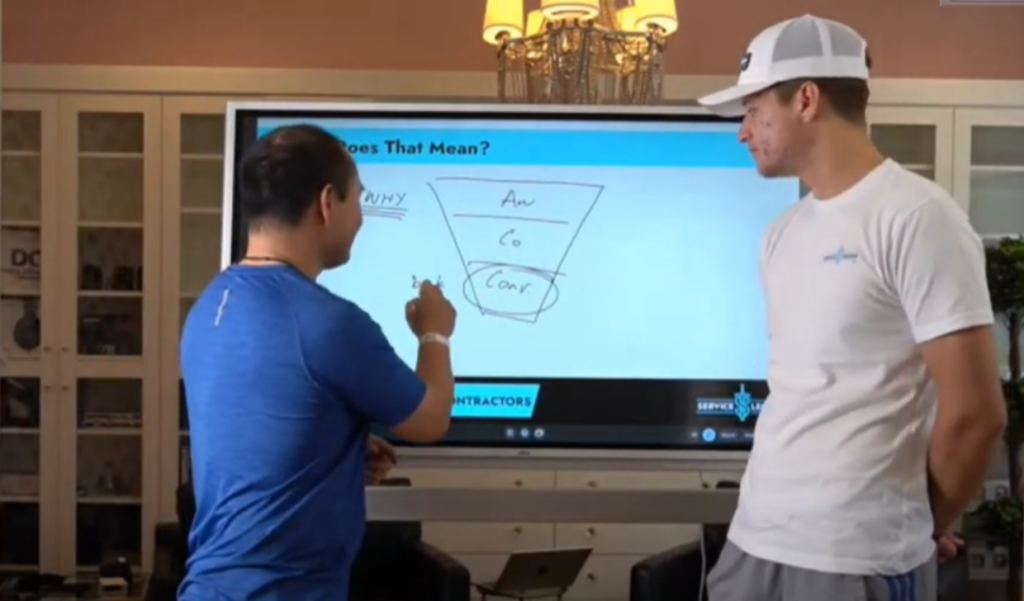
Anyone who understands marketing knows why their ads don’t work: this method is too direct, like using a pickup line that goes straight for the sale.
Everyone knows how to sell, but a lot of people mess up in the first two stages, awareness and consideration.
When you take your audience down the funnel, starting with awareness, showing you’re human, you’re not another name in the sea of your competitors anymore – You stand out from the rest.
When people are making a decision on who’s going to do their floors, do you think they can really tell who the best flooring contractor is?
They can’t. They simply choose someone they like.
I’ve been in internet advertising for 30 years, and while I thought people should hire based on reviews, skills or the kind of equipment someone had, I discovered that’s not true.
Take babysitting as an example. If you need a babysitter for a date night and have to choose between the familiar girl next door, who is okay, and another girl you don’t know but who has a perfect resume, most people would pick the girl next door because they know her.
People choose based on familiarity and shared values. They pick the person whose ‘funnel’ they’ve gone through, which means they’ve seen their stories a few times, maybe online or around the neighborhood (awareness), and then seen them in action (consideration). This leads to them making a decision (conversion).
That’s really what it boils down to.
A lot of people think that Dollar a Day is good for just the top and middle of the funnel. But what most people don’t know is that if you’re not using Dollar a Day for the bottom and the most important part of the funnel, you’re losing a lot of money.
When you use a Dollar a Day to create awareness around your business and filter out your winning ads, you can use these ads on any part of the funnel, while building audiences that you can retarget.
The Hidden Costs of Conversion-Only Advertising Strategies
Over the past two years, with the rise of TikTok-style short-form content, it’s become evident that on social media, people have an attention span of a gnat.
When you boost a conversion ad that’s about a minute long and packed with information, but viewers drop off after just the first two seconds, the remainder of your ad as well as your investment is wasted.
This is why we implement the Dollar a Day strategy: to sift through and invest more in ads that hold attention beyond those first critical seconds, ensuring you get the best return on your ad budget.
When your goal is to generate leads, which means you’re focusing on the bottom of the funnel, precise targeting is essential.
So how do you make sure you’re reaching your ideal audience?
For 50 years, the concept that was going around was, a customer needs to see your ad seven times to take action.
Now, recent research from platforms like TikTok, Facebook, and Google shows you need up to 60 touches.
This doesn’t mean hammering your audience with the same message 60 times, like you might with billboards or direct mail.
The increase in social media advertising in fields like coating and painting over the past five years, has made these platforms very competitive.
To stand out now, your audience needs to see you in different parts of your funnel, and then they Google your name.
If you jump straight to using conversion ads targeted at a cold audience, you might occasionally get lucky with sales.
However, focusing solely on conversion ads and neglecting the awareness and consideration stages of the funnel typically means you’ll spend three times your cost per conversion to secure a sale on platforms like Facebook or Google.
For instance, if it costs $60 to receive a call from a potential customer, you might end up spending around $180 to actually close a sale. The numbers simply don’t work in your favor.
Maximizing Ad Spend: Why Awareness Campaigns Outperform Direct Conversions
Let’s say you have two ad options, A and B.
Option A: Run a single conversion-focused ad. This ad could be something like “Call us now for a free estimate” or a “$79 offer.”
The average cost per thousand impressions (CPM) for this type of ad is about $60. If you spend $1000, you could reach up to 17,000 people.
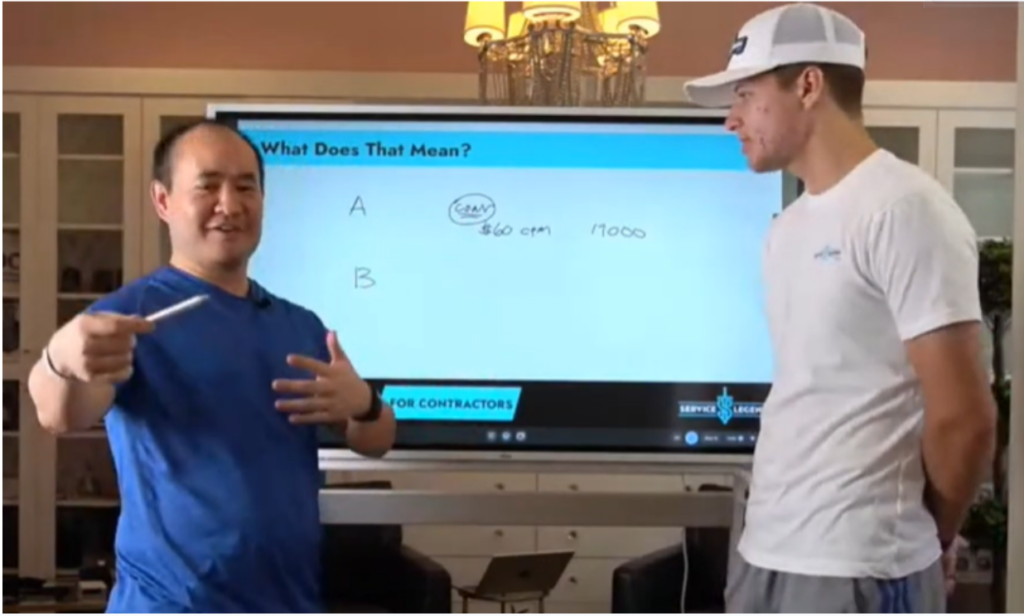
However, these people are a cold audience, so you have a high chance of getting dinged. This means your ad might not be relevant to them, leading to low click-through rates (CTR) and higher negative feedback.
As a result, your Relevance Score decreases and your CPM could go as high as $200.
The same is true for Google.
A higher click-through-rate CTR gets you a discount. This is because your Quality Score goes up. So if you double your CTR, the cost is now half.
Basically, when you’re targeting a cold audience who has not been warmed up by the top and middle of your funnel, and who doesn’t react positively towards your ad overall, it’s very unlikely for your ads to be profitable.
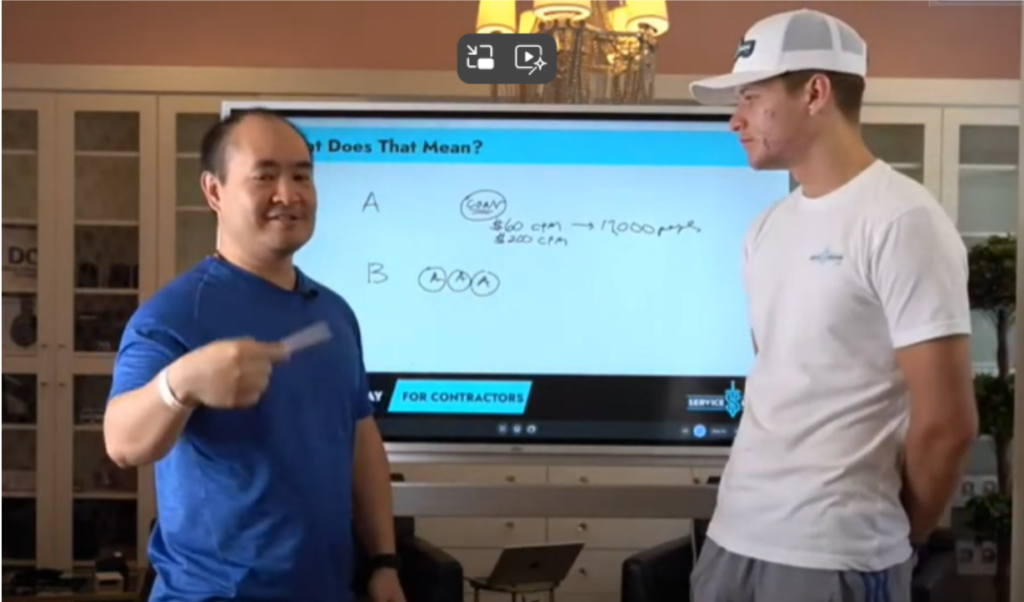
Option B: Focus on awareness. Run multiple awareness ads. It could be three awareness in a row. It could be sequenced together. It could just be a single campaign at the top of the funnel. These ads could be simple boosted posts.
What’s the CPM going to be? Only about $5 or less. Which is 1/12th of the CPM of the previous option. So for the same $1000, you could reach up to 300,000 people, giving you 10 impressions per person if you’re targeting a city of 30,000 people.
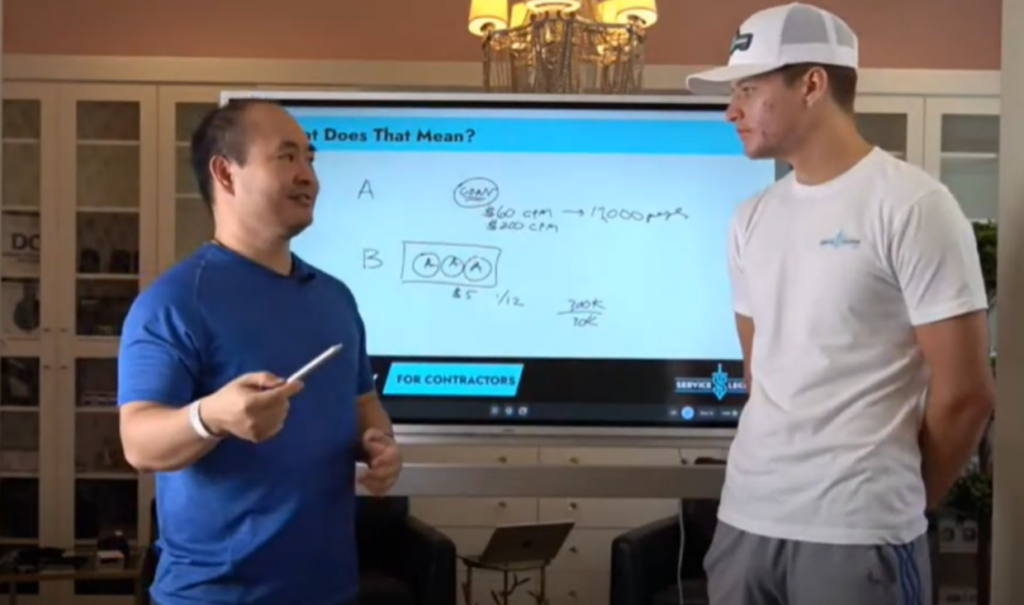
The algorithm can then identify the best-performing ad.
These ads are not meant to drive conversions directly but to engage the audience with high ThruPlay rates (15-second views). A 20% ThruPlay rate, double the Facebook average, indicates a good hook. This approach costs about 10 cents per ThruPlay.
When you find a successful awareness ad, you can invest more in it, building a pool of engaged users for remarketing.
Now, when you run conversion ads, even without direct remarketing, the algorithm targets the warmed-up audience, lowering your CPM to around $30.
This approach yields more leads. For example, if a conversion ad initially generated 20 leads (with Option A), it could now generate 35 leads from a warmed-up audience (Option B).
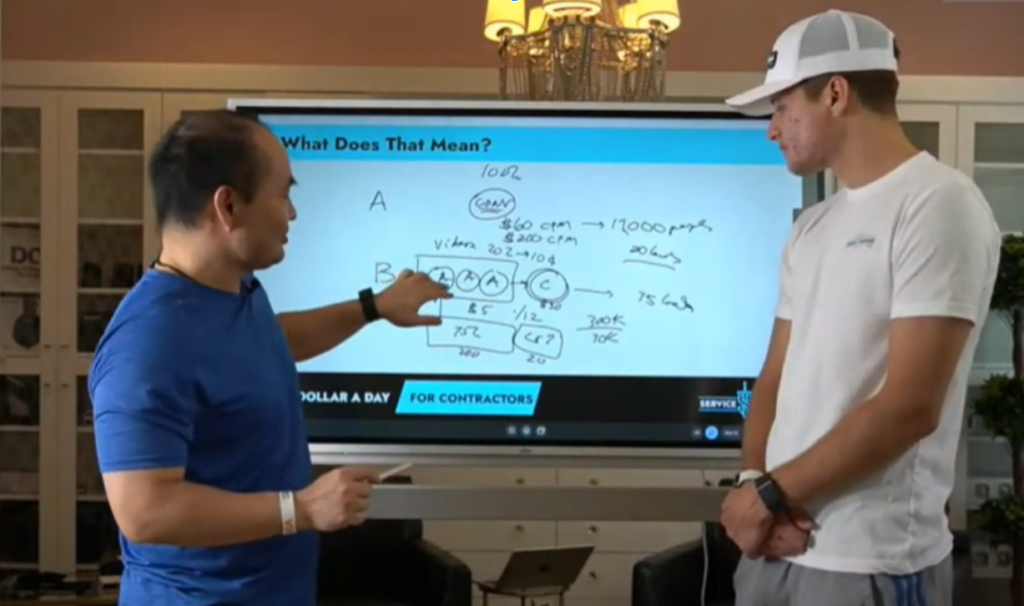
In summary, building awareness first with 75% of the budget, then using the remaining 25% to remarket to the warmed-up audience (Option B), results in a much lower cost per lead compared to targeting a cold audience directly (Option A).
This method also reduces the risk of losing money on untested ads. With Dollar a Day, the maximum you spend on a non-performing ad is $7. If the CTR is less than 10%, you remove that ad from your pool.
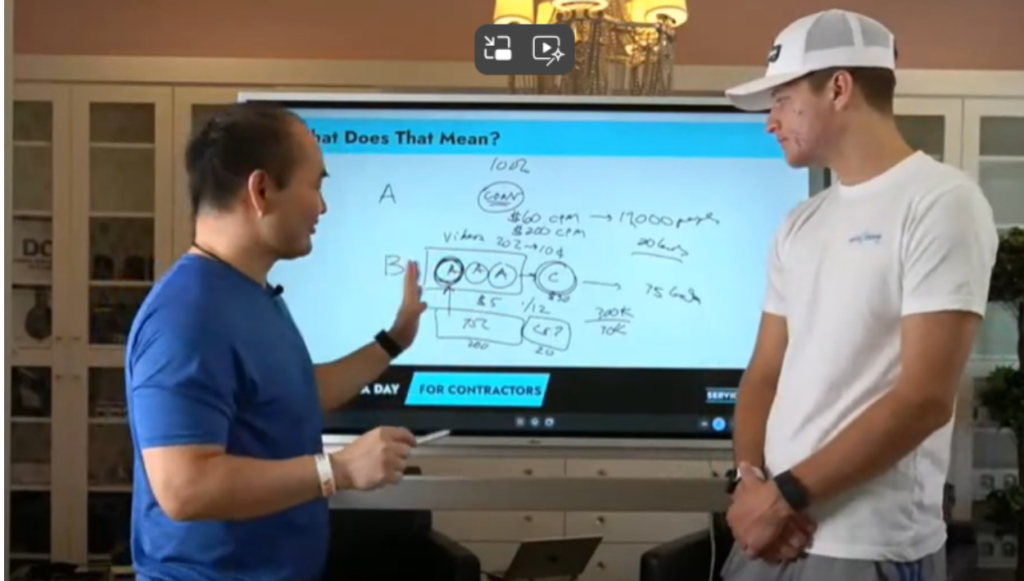
When you find a winning ad, you invest more in it, which builds momentum. These ads can run evergreen, meaning you don’t need to constantly create new ones. This is the key benefit of the Dollar a Day strategy – it’s a momentum builder.
Once you identify a successful ad, let it run indefinitely at $2 or $3 a day, and continue finding more winners.
This makes your conversion more powerful over time. But this does take 90 days 100 days to go through the testing cycle to build up these audiences, similar to achieving long-term fitness goals like getting six-pack abs. This process demands consistent effort and patience.
A Live Dollar a Day Demo for Contractors
For contractors, simply calling out your city in big text and stating what you do can be effective. For example, “Hey, Atlanta, Georgia, do you need a new garage door?”
Follow that with your experience, a quick introduction to your team, or behind-the-scenes work like technicians painting or installing something. This makes your video relatable and engaging.
Next, target your ad to specific neighborhoods, existing customers, competitors, or even specific subdivisions. Platforms like Facebook, Google, or others will then sub-target those people. Even with a small budget, the algorithms dig deep into data to locate your potential customers.
At the World of Concrete, during a small session, I asked the audience if someone would like to volunteer for a quick dollar a day campaign live.
A contractor specializing in concrete floors from Shawnee, Kansas volunteered. I asked him to say, “Hey, Shawnee, Kansas, would you like your concrete floors to look like this?”
We filmed this short clip on stage and ran the ad for a dollar a day, targeting people in Shawnee. The click-through rate was impressive – 27%! Over a quarter of the people who saw our ad engaged with the video.
We did this on Twitter, where investing slightly more than a dollar a day can yield even better results. Other platforms like TikTok are cheaper. You can use this strategy on any platform that uses algorithms to deliver content based on user preferences and demographic data, including Google.
If you run a home service business, like a painting company in Arizona, you can use this strategy to become a LIGHTHOUSE in your industry, making your audience see you as the leading painting company in Arizona.
Creative Uses of the Dollar a Day Strategy: Real-World Examples
In Phoenix, there’s a well-known car dealership called Earnhardt Chevrolet. My friend Bryce Clark got a used car from them, but it wasn’t ready. The general manager agreed to pay for a rental car until Bryce’s car was ready, but later refused, leaving Bryce, an 18-year-old, with the bill.
I advised Bryce to post a screenshot of the manager’s promise. He created a blog and posted his story. Of course, he asked the manager again to reimburse before we started a dollar a day campaign against the blog story, but he ignored.
We then started a Dollar a Day campaign targeting Earnhardt Chevrolet employees, who started to engage on our post. What do you think happened? We had a 23 percent engagement rate.
The funny thing was, right before we launched our ad, the company’s general manager claimed,
“I don’t care what you say on Yelp, Google, or social media because you can’t threaten me, and you can’t get anything.”
Just for fun, we also targeted the executives at General Motors in Detroit. Within two days, GM executives involved with Chevrolet were asking,
“What’s going on with Earnhardt Chevrolet?”
Three days later, the general manager called Bryce, overwhelmed by calls from corporate, and quickly reimbursed Bryce.
The Dollar a Day strategy worked because it targeted precisely the right people.
Here’s another story: My friend Eric Ludwig recently turned 50. He was the Chief Marketing Officer at Rosetta Stone, a well-known language learning company.
I created a Facebook ad to wish him, saying, “Hey Eric, you don’t look a day over 49. You’re looking good, my friend.” I targeted the ad to all the employees at Rosetta Stone’s headquarters in Rosslyn, Virginia, specifically the 250 people in the marketing department.
The next day, I received a cease and desist from their chief legal officer. They thought I was spending millions on these ads because they were seeing them everywhere. In reality, the campaign cost only a dollar a day. Yes, just 83 cents!
The overall point is, you can reach whoever you want to reach for as little as a dollar a day, whether you’re a contractor, an insurance company, or any other home service business.
Key Points
- 80% of your ad success depends on the initial setup.
- Use the Dollar a Day strategy to test various ad versions to identify the most effective ones.
- Shift from specific interest targeting to broader geographic targeting for better results.
- Focus on all stages of the marketing funnel: Awareness, Consideration, and Conversion.
- Use why stories to create a personal connection and build awareness.
- Avoiding Conversion-Only Campaigns: Integrate awareness campaigns to reduce cost per lead and increase effectiveness.
What specific challenges have you faced in your local business advertising, and how do you plan to apply the Dollar a Day strategy to overcome them?
What specific challenges have you faced in your social media advertising, and how do you plan to apply the Dollar a Day strategy to overcome them?
